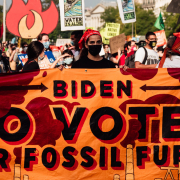Blue States Should Let ESG Die
Life is going from bad to worse for the ESG movement. This weekend, activist investor Bluebell Capital began a new battle to try and force BlackRock into overhauling its commitments to environmental, social and governance (ESG) investing, marking another step back for the movement.
Whether Bluebell will be able to successfully influence BlackRock remains to be seen, but the winds are blowing in its favour. Recently, it was reported that ESG funds faced their worst year on record in 2023, while funds classified as “responsible investing” shrunk last year by more than half (down from $158 billion to $68 billion).
Those who suffer the most are the pensioners and taxpayers living in blue states where ESG investing is most prevalent. One key example is California’s CalPERS, the country’s largest pension fund, which represents roughly two million state employees and their families. CalPERS plans to boost its climate-influenced investments by $100 billion by 2030, even though it faces an enormous $300 billion pension shortfall, three times that of Texas. But considering that the fund’s returns on investment remain consistently below those of the stock market, it is difficult to see how it will dig itself out of this hole.
California’s fealty to green initiatives is clearly hurting the state, but it’s not the only one. New York’s pension funds are doing much the same, with plans to divest from oil and gas and double investments in green energy companies. New York’s pension funds are already an established underperformer in the stock market and, like CalPERS, these entities seem more interested in placating the powerful, oligarch-financed greens than attending to their fiduciary duties.
By contrast, Republican state legislatures — including those in Florida, Kansas and Idaho — have passed laws that ban or limit the consideration of ESG, providing direct opposition to these green investment pledges. It’s no wonder, then, that Idaho and Florida have earned among the highest returns according to NASDAQ.
Red states have clearly cottoned onto a reality that blue states have missed. Overall, renewable energy stocks have lost a sum to the tune of $30 billion this year, with the entire EV sector including Tesla showing weakness. Some EV firms such as Fisker, may not be long for the world while solar and wind generation facilities are wearing out about twice as quickly as expected. Apple recently abandoned its EV project, racking up billions in losses. At the same time, fossil fuel companies and stocks have once again become market favourites.
Years ago, Treasury Secretary Janet Yellen assured Americans that climate change would provide “the greatest economic opportunity of our time”. Such sentiments sparked a green gold rush, with the Financial Times estimating that more than $200 billion was invested in “cleantech” projects in the United States alone. But rising prices for materials and the end of cheap money have forced energy firms to raise their prices, which in turn have hurt consumers.
Read the rest of this piece at UnHerd.
Joel Kotkin is the author of The Coming of Neo-Feudalism: A Warning to the Global Middle Class. He is the Roger Hobbs Presidential Fellow in Urban Futures at Chapman University and and directs the Center for Demographics and Policy there. Learn more at joelkotkin.com and follow him on Twitter @joelkotkin.
Homepage photo: Victoria Pickering via, Flickr, under CC 2.0 License.









